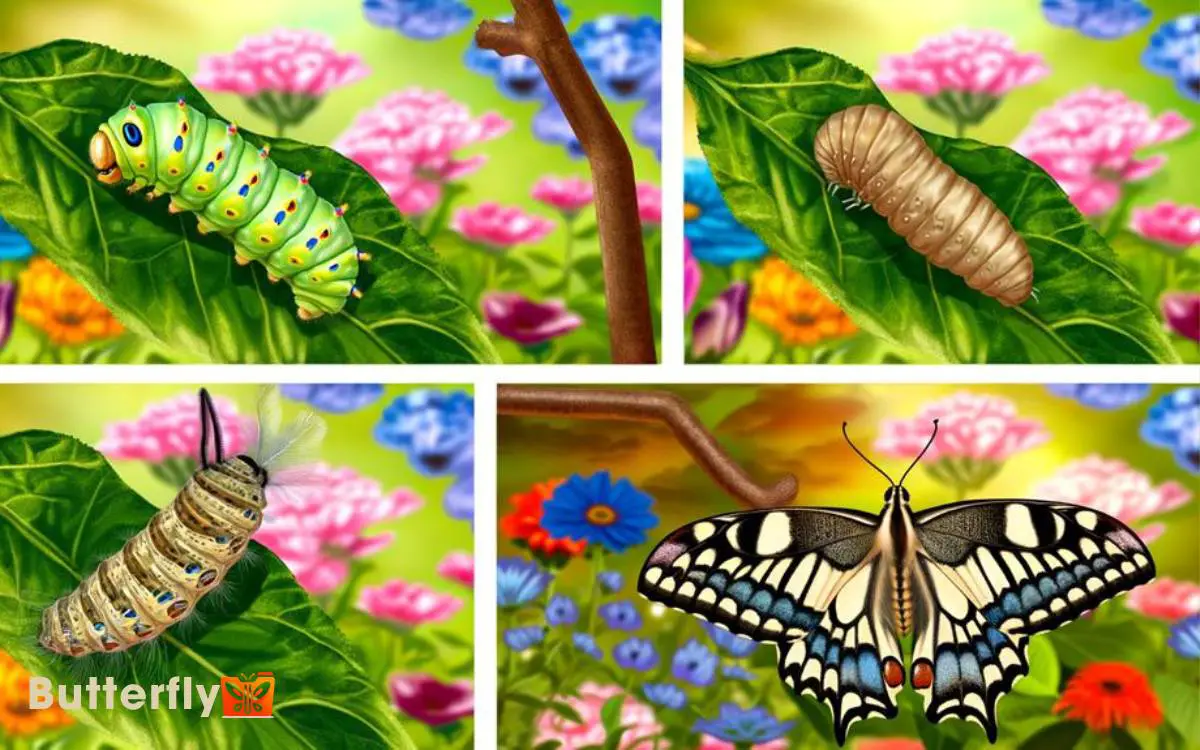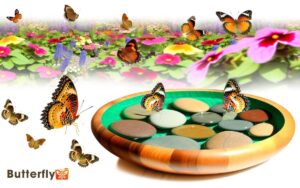Can Moths Turn Into Butterflies? Metamorphosis Mystery!
Moths can’t turn into butterflies, as they’re distinct species with separate evolutionary paths. Both undergo complete metamorphosis, but moths form cocoons while butterflies create chrysalises.
Understanding these details allows you to appreciate the fascinating evolutionary traits and ecological roles each plays. By exploring further, you’ll uncover even more intriguing distinctions.

Key Takeaways
Life Cycle of Moths
Understanding the life cycle of moths requires examining their transformation through four distinct stages: egg, larva, pupa, and adult. Initially, a female moth lays hundreds of tiny eggs on suitable host plants.
You’ll notice that these eggs hatch into larvae, commonly known as caterpillars, which voraciously consume plant material to fuel rapid growth. This larval stage is essential for accumulating energy reserves.
Following this, the larva forms a protective casing called a pupa or chrysalis. During the pupal stage, it undergoes metamorphosis, reorganizing its tissues into adult structures.
Life Cycle of Butterflies
Much like moths, butterflies undergo a complex metamorphosis, progressing through the stages of egg, larva, pupa, and adult.
You start by observing the eggs, typically laid on host plants. These hatch into larvae, or caterpillars, which voraciously consume leaves to fuel their growth.
Next, the caterpillar enters the pupal stage, forming a chrysalis. Inside this protective casing, it undergoes remarkable transformation. Its body structure is entirely reorganized, developing wings, antennae, and other adult features.
Finally, the adult butterfly emerges, ready for reproduction and nectar feeding. Each stage is essential and highly specialized, driven by genetic and environmental factors.
Understanding these stages provides insight into the intricate life processes of butterflies and their role in ecosystems.
Key Differences in Metamorphosis
When comparing the metamorphosis of moths and butterflies, you’ll notice distinct differences at each life cycle stage.
The pupal stage, in particular, shows significant contrasts, with moths forming a cocoon and butterflies forming a chrysalis.
These variations in their development lead to notable morphological transformations, highlighting their unique evolutionary adaptations.
Different Life Cycle Stages
In examining the life cycle stages of moths and butterflies, you’ll find that both undergo complete metamorphosis, yet they exhibit distinct differences at each transformation stage.
Starting from the egg, moths often lay clusters, while butterflies typically lay single eggs.
As larvae or caterpillars, moths generally have a smooth or slightly hairy appearance, whereas butterfly caterpillars are often more vibrant and adorned with intricate patterns.
During the larval stage, moth caterpillars are more likely to be nocturnal feeders, while butterfly caterpillars feed during the day.
These differences extend into the chrysalis and pupation stages, reflecting each species’ adaptations to their environments.
Understanding these stages gives you a clearer view of their evolutionary paths and ecological roles.
Pupal Stage Differences
Unlike butterflies, moths form a cocoon around themselves during the pupal stage, providing an extra layer of protection that highlights their distinct evolutionary adaptations.
You’ll find that this cocoon is typically composed of silk, offering a robust defense against predators and environmental hazards.
Butterflies, however, encase themselves in a chrysalis, which, unlike the cocoon, is a hardened exoskeleton without an additional silk covering. This protective casing allows the butterfly to undergo metamorphosis, transforming from a caterpillar into its final form. When the time is right, the chrysalis splits open, helping a butterfly emerge with soft, folded wings. After a short period of drying and strengthening, the butterfly is ready to take its first flight.
This difference is essential for understanding their respective survival strategies. Moth pupae are less visible due to their silk coverings, giving them a camouflage advantage.
In contrast, butterfly chrysalises are often exposed, relying more on their durability and sometimes cryptic coloration to evade threats. These distinctions underscore the unique evolutionary pathways each has taken.
Morphological Transformation Contrasts
Metamorphosis in moths and butterflies involves distinct morphological transformations that are pivotal in understanding their developmental biology.
You’ll notice that moths typically spin a cocoon made of silk, encasing themselves for protection during the pupal stage. Butterflies, on the other hand, form a hardened chrysalis without a silk covering.
These differences extend to their adult structures; moths often possess feathery antennae and robust, furry bodies, adapted for nocturnal activity. Butterflies exhibit slender bodies and club-shaped antennae, suited for diurnal life.
Additionally, moth wings are usually drab and camouflaged, while butterfly wings are vividly colored, aiding in mate attraction and predator deterrence.
Understanding these morphological contrasts helps explain how each species has evolved to thrive in their respective ecological niches.
Common Misconceptions
Many people mistakenly believe that moths can transform into butterflies, but these two insects actually belong to entirely different groups within the order Lepidoptera.
Moths fall under the suborder Heterocera, while butterflies are classified under Rhopalocera. This fundamental distinction means that their life cycles, behaviors, and anatomical features are inherently different.
For instance, moths typically have feathery or comb-like antennae, whereas butterflies possess club-shaped antennae. Moths often rest with wings spread flat, while butterflies usually hold their wings upright.
Understanding these differences helps clarify why moths and butterflies are distinct entities from the moment they hatch as caterpillars.
Dispelling this common misconception is essential for appreciating the unique roles each plays in their ecosystems.
Evolutionary Paths
Exploring the evolutionary paths of moths and butterflies reveals fascinating divergences that underscore their distinct adaptations and survival strategies.
When you investigate their phylogenetic trees, you’ll notice that both groups share a common ancestor. However, millions of years of evolution have led them down separate paths, resulting in unique physiological traits.
Moths often evolved to thrive in nocturnal environments, developing muted colors and more robust bodies. Butterflies, conversely, adapted to diurnal lifestyles, which favored bright coloration and slender, delicate structures.
Understanding these evolutionary trajectories helps you appreciate how each group capitalized on different ecological niches. This divergence is key to why moths can’t turn into butterflies; they’re fundamentally different branches of the Lepidoptera order.
Ecological Roles
You mightn’t realize it, but moths and butterflies play vital roles in ecosystems. They assist in pollination and plant reproduction, serve as a food source for numerous predators, and contribute to biodiversity and ecosystem health.
Understanding these roles can help you appreciate their ecological importance beyond their aesthetic appeal.
Pollination and Plant Reproduction
Moths play an essential role in pollination and plant reproduction by transferring pollen between flowers during their nocturnal activities. You might be surprised to learn that many plants depend on moths for successful pollination.
As moths seek nectar, they inadvertently pick up pollen on their bodies and carry it to the next flower. This process guarantees genetic diversity and the production of seeds. Certain flowers have even evolved to attract moths specifically, emitting strong scents at night.
Food Source for Predators
Ever wonder how moths sustain a diverse array of predators within ecosystems?
Moths, both in their larval and adult stages, are essential food sources for numerous species. Birds, bats, spiders, and small mammals rely heavily on moths to meet their dietary needs.
The larval stage, or caterpillars, provide important protein and nutrients, supporting the growth and reproduction of these predators.
Adult moths, with their nocturnal activity, are particularly significant for nocturnal predators like bats. By serving as prey, moths contribute to the energy flow within food webs, ensuring the survival of various predator species.
This consumption helps maintain ecological balance, underscoring the significant role moths play in sustaining biodiversity and predator populations.
Biodiversity and Ecosystem Health
Delving into the ecological roles of moths reveals their significant contributions to biodiversity and ecosystem health.
As you explore, you’ll find that moths are indispensable in various ways:
- Pollination: Moths are nocturnal pollinators, aiding in the fertilization of many night-blooming plants.
- Food Web Integration: They serve as an essential food source for birds, bats, and other predators, maintaining the balance within ecosystems.
- Nutrient Recycling: Moth larvae break down plant material, contributing to nutrient cycling and soil health.
- Biodiversity Indicators: Moth populations reflect environmental changes, making them excellent bioindicators for ecosystem monitoring.
Understanding these roles underscores their importance in maintaining ecological balance and promoting biodiversity. Your awareness of these functions can enhance conservation efforts and ecosystem management strategies.
Appreciating Moths and Butterflies
Why not take a moment to marvel at the intricate patterns and diverse adaptations that both moths and butterflies exhibit in their respective ecological niches?
Moths, often nocturnal, possess muted colors and fuzzy bodies, optimizing them for nighttime pollination and camouflage. Their antennae are feathery, enhancing their sensory capabilities in the dark.
Butterflies, on the other hand, display vibrant hues that serve as warning signals or mating cues during daylight. Their slender bodies and clubbed antennae aid in precise navigation.
Both insects have evolved unique mechanisms for survival, such as mimicry and cryptic coloration. By appreciating these differences, you’ll gain a deeper understanding of their roles in pollination, biodiversity, and the broader ecological balance.
Conclusion
In the grand tapestry of nature, moths and butterflies each weave their own unique threads. You’ve seen how their life cycles, though similar, are distinct paths of transformation.
By understanding these differences, you’ll appreciate their evolutionary journeys and ecological roles more deeply. So next time you see a fluttering wing, remember: it’s not just a random insect, but a proof of nature’s intricate design and adaptability.






